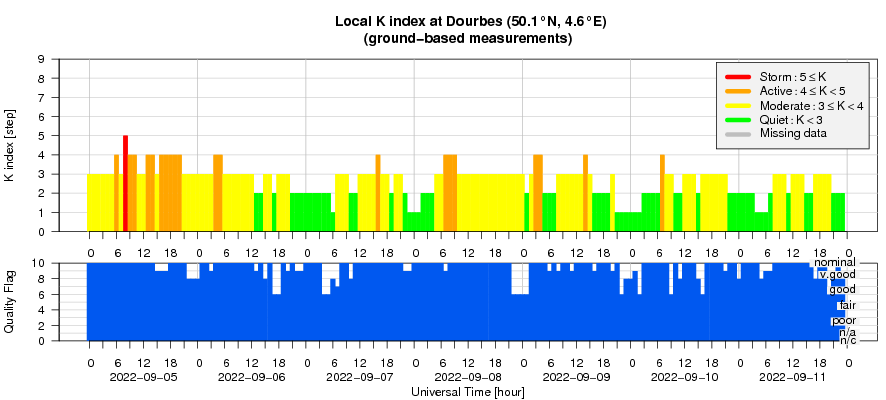- Table of Content
- 1.NOAA 3088: the...
- 2.The STCE in 20...
- 3.Alarm, solar s...
- 4.Review of sola...
- 5.Review of geom...
- 6.PROBA2 Observa...
- 7.The Internatio...
- 8.Noticeable Sol...
- 9.Geomagnetic Ob...
- 10.The SIDC Space...
- 11.Action!
2. The STCE in 2020
3. Alarm, solar storm on the way
4. Review of solar activity
5. Review of geomagnetic activity
6. PROBA2 Observations (5 Sep 2022 - 11 Sep 2022)
7. The International Sunspot Number by SILSO
8. Noticeable Solar Events (5 Sep 2022 - 11 Sep 2022)
9. Geomagnetic Observations at Dourbes (5 Sep 2022 - 11 Sep 2022)
10. The SIDC Space Weather Briefing
11. Action!
NOAA 3088: the sequel
The previous STCE Newsitem (https://www.stce.be/news/602/welcome.html ) discussed the complex and flare-productive active region NOAA 3088, commenting on the continued activity while the sunspot group had already well rounded the southwest solar limb late on 28 August. On 5 September, it produced a halo CME (coronal mass ejection) while directly opposed to the Earth on the farside of the Sun. The COR2 instrument on board STEREO-A (https://stereo-ssc.nascom.nasa.gov/ ), which trails the Earth now by less than 20 degrees (or about 50 million km), was able to image this CME in all its splendour as can be seen in the imagery underneath and the clip in the online version of this newsitem at https://www.stce.be/news/604/welcome.html The plane-of-the-sky speed of the CME was calculated to be well over 1000 km/s. Interestingly, early on 8 September, the greater than 10 MeV proton flux very gradually started to increase, but never reached the alert threshold. The proton flux enhancement is thought to be a late effect from the farside activity on 5 September, as there were no obvious, more recent, strong solar events in a position that may have affected the earth environment.
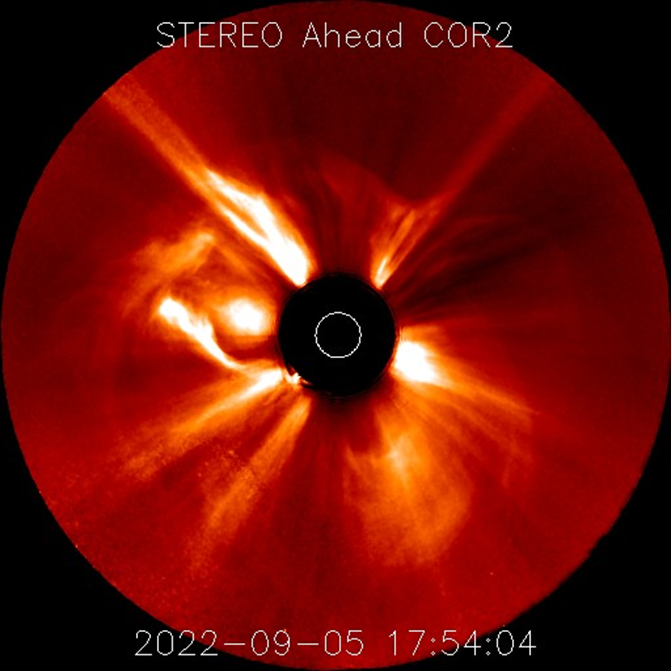
NOAA 3088's farside transition can nicely be tracked in the synoptic maps underneath right, showing the entire solar surface between latitudes +60 and -60 degrees. They are compiled from full disk SDO/HMI magnetograms (https://sdo.gsfc.nasa.gov/data/aiahmi/ ), which is the gray-green-yellowish colored portion portraying the earth-view, and from helioseismograms (JSOC/Stanford: http://jsoc.stanford.edu/data/timed/), which is the orangish colored portion representing the farside view. In the helioseismograms, the dark spots are areas of enhanced magnetic activity such as e.g. sunspot groups. The location of active ragion NOAA 3088 is indicated with a white circle on the map, as well as in the SDO imagery (upper left: white light ; lower left: extreme ultraviolet (EUV)). Note that though the dates are the same (resp. 27 August, 5 and 11 September), the timings between the synoptic maps and the other images differ by a few hours.
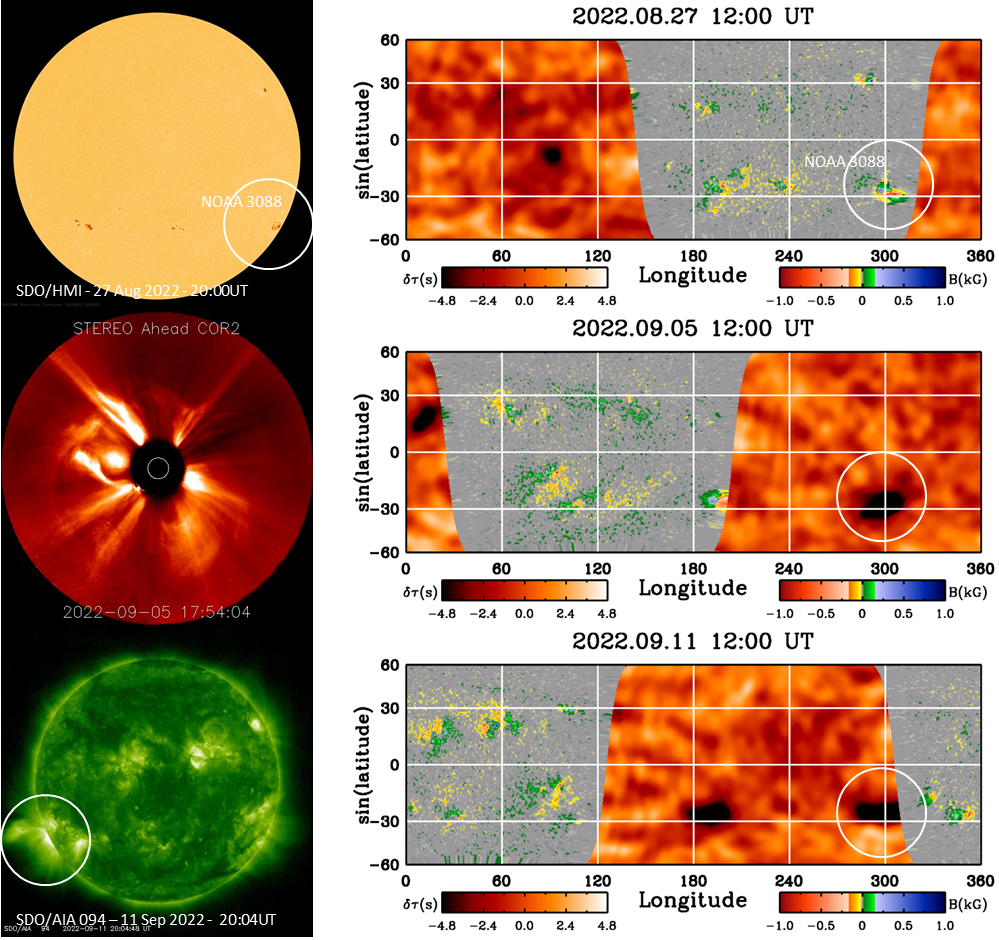
The dates in the figure above were chosen to show resp. NOAA 3088 just before its rounding of the solar southwest limb, the halo CME, and just before NOAA 3088's rounding of the southeast solar limb. The region announced its reappearance with tall and dynamic coronal loops (in EUV), and had apparently already an influence on the 10.7 cm solar radio flux on 11 September, which enhanced with about 20 units from 131 to 151 sfu (solar flux unit, with 1 sfu = 10-22 W m-2 Hz-1) from 10 to 11 September. The graph underneath shows the evolution of the solar radio flux since 21 August. The data were corrected for solar flare contributions, i.e. the 17UT or 23UT value was taken if the 20UT value was flare-affected, such as on 28 August. The influence of NOAA 3088 (late August) and NOAA 3089 (early September) can clearly be distinguished. The fast rise on 11 September is most likely due to the reappearance of NOAA 3088, but increasingly complex active regions NOAA 3098 and 3101 in the northwest quadrant are almost certainly contributing too. So far, the freshly returned NOAA 3088 has shown little flare activity, but this may change in the days to come.
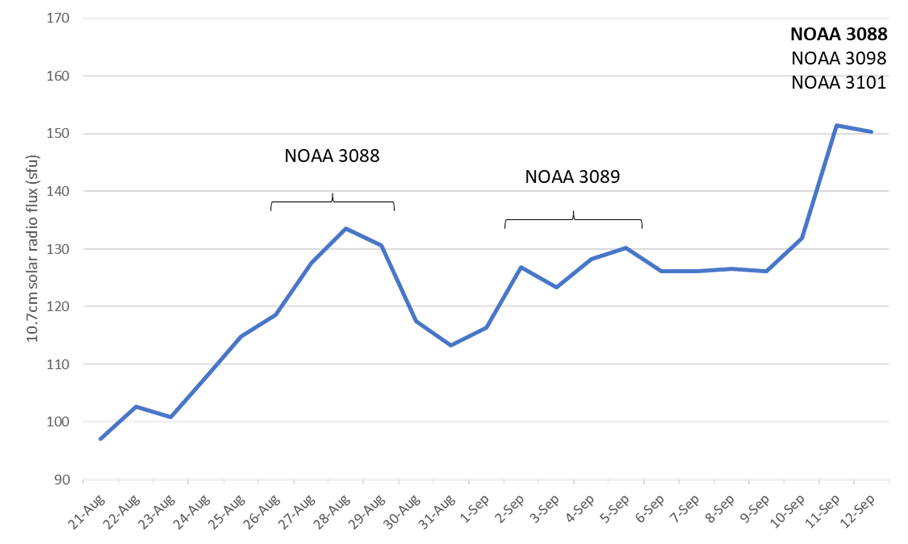
The STCE in 2020
The STCE Annual Report 2020 is now available at https://www.stce.be/annualReport
It is a compilation of the activities done in 2020 within the frame of the Solar-Terrestrial Centre of Excellence (STCE). This report continues the style from the previous editions. Hence, as it is targeting a more general public, it presents only a selection of the 2020-activities in easy-to-digest summaries.
These bite-sized articles emphasize the intense collaboration between the institutes at the Space Pole, as well as with our external partners. Aside the usual topics such as the space weather highlights, public outreach, and listings with conference talks and science papers, it covers also contributions on e.g. Solar Orbiter and its Extreme Ultraviolet Imager, the Earth's radiation belts, Travelling Ionospheric Disturbances, the BRAMS transmitter, a space anemometer for the lower thermosphere,... amongst many other. The year "2020" will certainly be remembered as the COVID year, and so some funny signs were added reflecting our life with and during this crisis in a quite recognizable way.
We wish you an enjoyable reading experience!
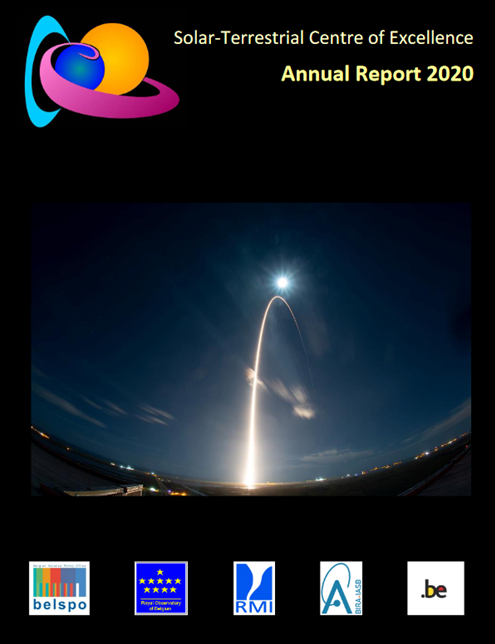
Alarm, solar storm on the way
☀️⚡️ Imagine a life without internet, GPS or even electricity. Sounds like a horror scenario, doesn't it? Yet our own Sun can take care of it. And how? Find out at the STCE children's conference 'Alarm, solar storm on the way',
Sunday 25 September at 4.30 pm (in Dutch) #opendoors #spacepole #STCE

Review of solar activity
Flares
Solar flaring activity was low, with the only exception of an M1 flare from NOAA Active Region (AR) 3089 (Catania group 22) on 05 Sep 18:05 UTC. In total 55 C-class events were detected during the week, mostly emitted from NOAA AR 3088, 3089, 3098, and 3100.
Coronal Mass Ejections - CME
A partial halo CME was observed. It was back-sided and did not have an effect on Earth.
Energetic particles near Earth
The greater than 10 MeV proton flux was below the 10 pfu alert level, however there was a significant increase on 9 Sept that peaked at 6 pfu .
The greater than 2 MeV electron flux was above the 1000 pfu threshold during most of the week.
The 24h electron fluence was at moderate levels (between 5E+7 and 5E+8 electrons/cm2-sr-day) with the exception of 8 and 9 Sep, when it reached high levels (up to 7E+8 electrons/cm2-sr-day on 9 Sep).
Review of geomagnetic activity
The Solar Wind (SW) was affected by the previous arrival (03 Sep) of a High Speed Stream (HSS). The SW speed gradually decreased from a maximum of 720 km/s on 5 Sep to 400 km/s on 11 Sep.
The interplanetary magnetic field was mostly directed away from the Sun throughout the week. Its strength dropped from 10 nT on 5 Sep to 2 nT on 11 Sep, while its North-South component varied between negative and positive values in equal measure.
Global geomagnetic conditions were at minor storm level (NOAA Kp=5) for the hours of 00:00-06:00 and 09:00-12:00 UTC on 5 Sep. They gradually decreased to unsettled levels (NOAA Kp=3) at the end of the week, featuring many intervals of active levels (NOAA Kp=4) during the first part of the week.
PROBA2 Observations (5 Sep 2022 - 11 Sep 2022)
Solar Activity
Solar flare activity fluctuated from low to moderate during the week.
In order to view the activity of this week in more detail, we suggest to go to the following website from which all the daily (normal and difference) movies can be accessed: https://proba2.oma.be/ssa
This page also lists the recorded flaring events.
A weekly overview movie can be found here (SWAP week 650). https://proba2.sidc.be/swap/data/mpg/movies/weekly_movies/weekly_movie_2022_09_05.mp4
Details about some of this week's events can be found further below.
If any of the linked movies are unavailable they can be found in the P2SC movie repository here https://proba2.sidc.be/swap/data/mpg/movies/
Monday Sep 05
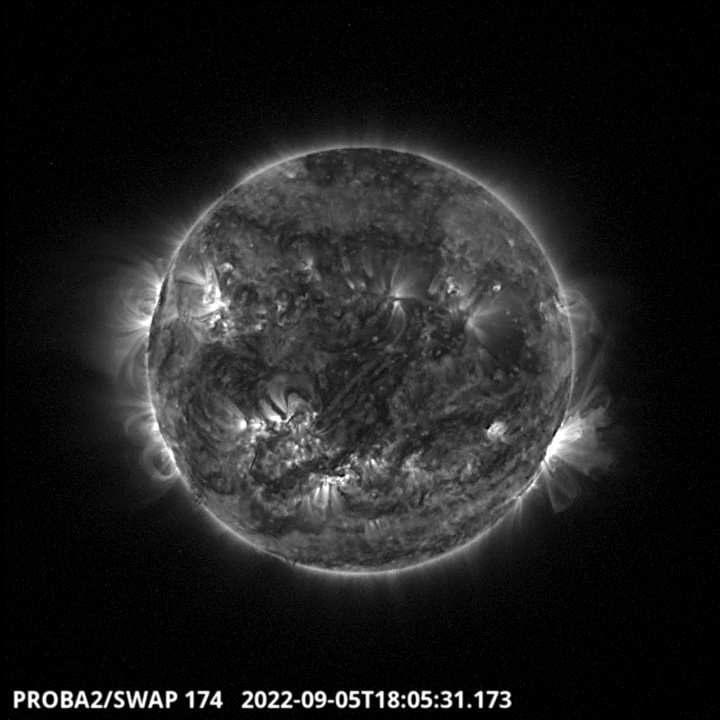
The largest eruption of the week ( a M1.0 flare ) was produced on the South West Limb around
18:05 UT - SWAP image. Find a movie of the event here (SWAP movie) https://proba2.sidc.be/swap/data/mpg/movies/20220905_swap_movie.mp4
The International Sunspot Number by SILSO
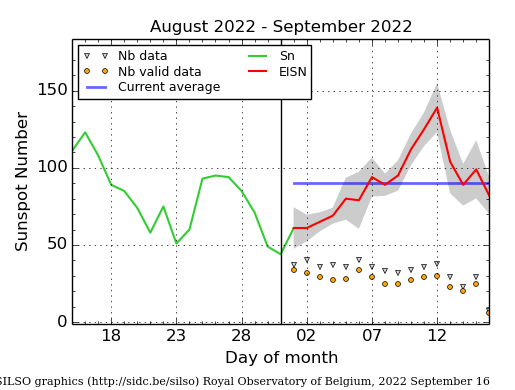
The daily Estimated International Sunspot Number (EISN, red curve with shaded error) derived by a simplified method from real-time data from the worldwide SILSO network. It extends the official Sunspot Number from the full processing of the preceding month (green line), a few days more than one solar rotation. The horizontal blue line shows the current monthly average. The yellow dots give the number of stations that provided valid data. Valid data are used to calculate the EISN. The triangle gives the number of stations providing data. When a triangle and a yellow dot coincide, it means that all the data is used to calculate the EISN of that day.
Noticeable Solar Events (5 Sep 2022 - 11 Sep 2022)
| DAY | BEGIN | MAX | END | LOC | XRAY | OP | 10CM | TYPE | Cat | NOAA |
| 05 | 1758 | 1805 | 1814 | M1.0 | 22 | 3089 |
| LOC: approximate heliographic location | TYPE: radio burst type |
| XRAY: X-ray flare class | Cat: Catania sunspot group number |
| OP: optical flare class | NOAA: NOAA active region number |
| 10CM: peak 10 cm radio flux |
The SIDC Space Weather Briefing
The Space Weather Briefing presented by the forecaster on duty from Sept 4 to 11 . It reflects in images and graphs what is written in the Solar and Geomagnetic Activity report: https://www.stce.be/briefings/20220912_SWbriefing.pdf
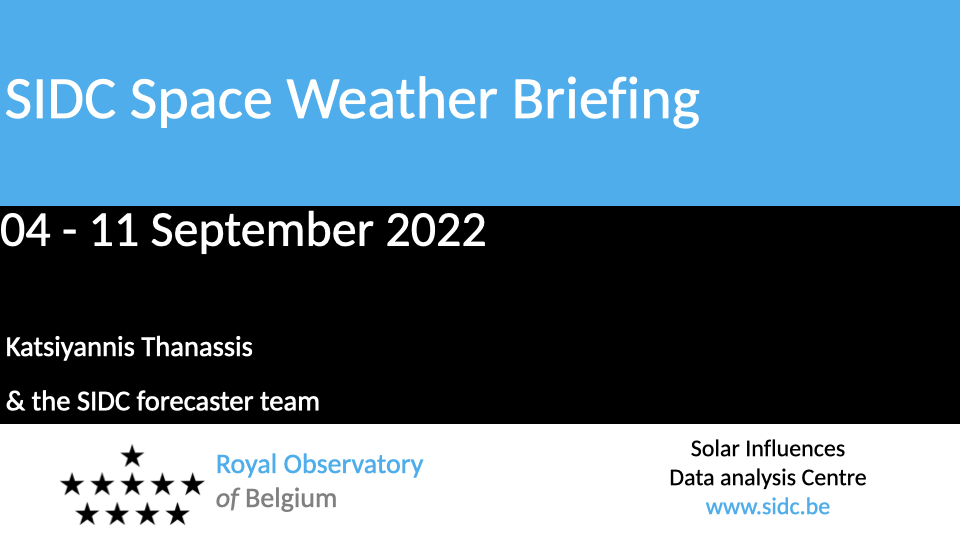
If you need to access the movies, contact us: stce_coordination at stce.be
Action!
Check out our activity calendar: activities and encounters with the Sun-Space-Earth system and Space Weather as the main theme. We provide occasions to get submerged in our world through educational, informative and instructive activities.
If you want your event in our calendar, contact us: stce_coordination at stce.be
* September 24-25 Space Pole Open Days, Brussels, Belgium
* September 24: STCE lecture (Dutch) at Space Pole Open Days: Noorderlicht: hemelse wetenschap
* September 25: STCE lecture (Dutch) at Space Pole Open Days: Alarm, een zonnestorm op komst!
* September 27: STCE seminar Solar Spectral Irradiance Variability, 2PM, onsite (@ROB) and online
* October 11, Webinar: Putting the FAIR principles into practice: the journey of a GNSS data repository, GNSS@Royal Observatory of Belgium
* October 24-28, 18th European Space Weather Week, Zagreb, Croatia
* November 21-23, Space Weather Introductory Course - onsite, by the STCE, Brussels, Belgium - fully booked
* December 5, 6, 8, 9, Space Weather Introductory Course - online, by the STCE, zoom - fully booked
Check: https://www.stce.be/calendar

